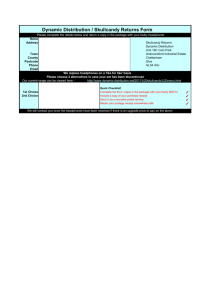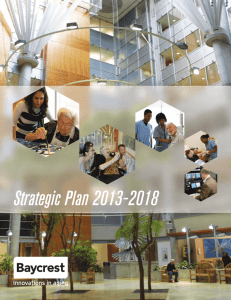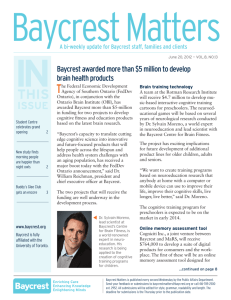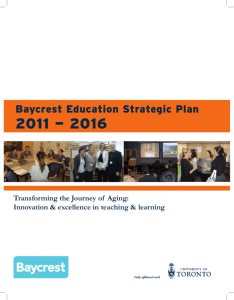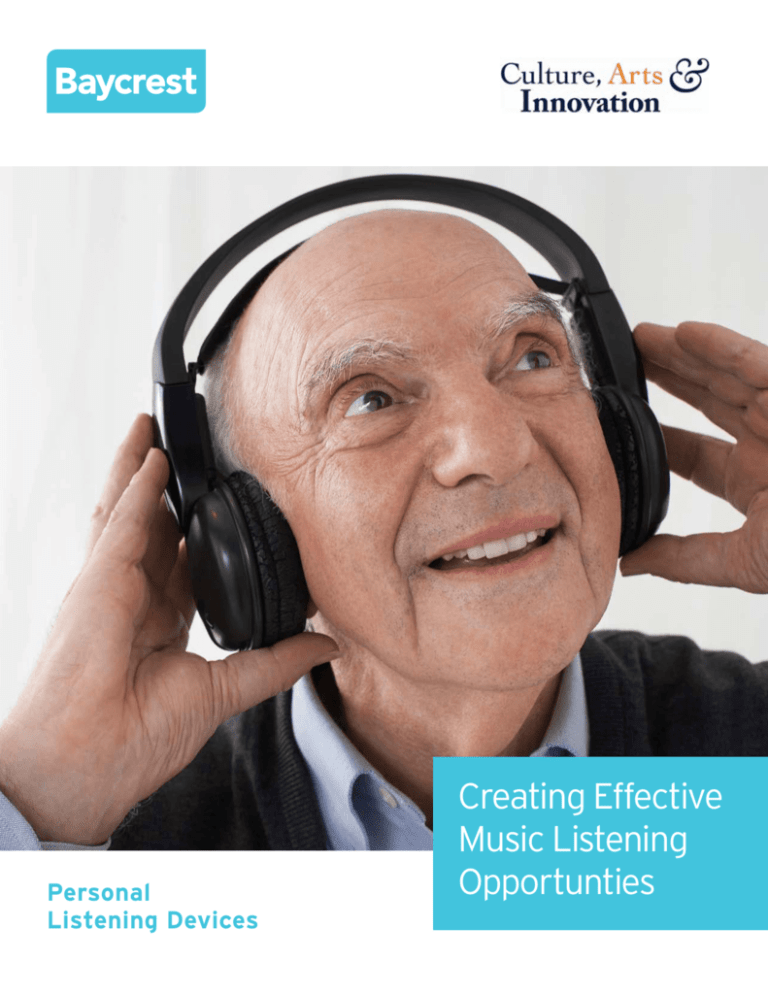
Personal
Listening Devices
Creating Effective
Music Listening
Opportunties
M us i c : A n I nteracti v e Ex per i enc e
In almost every culture music is meant to
be a social and interactive activity. While
we might listen to music on our own, older
generations did not grow up with digital
music that could be listened to at any time.
Music was (and still is) mostly enjoyed in
interactive ways. For example, at family
gatherings around the piano, at live
concerts, in dance halls, at weddings and
other celebrations, or on a record player
(digital music dock!) for all to hear. With the
new personalized listening movement, music
is being used in new and innovative ways.
In this brochure you will find information
on how and when to use a personalized
playlist, how to create effective playlists
and how to respond to deep emotions that
could result from music listening.
How and When to Use a
Personalized Playlist
When is a Good Time to
Listen to a Playlist?
In general, there are many appropriate times and
reasons to offer opportunities to listen to music.
For example: when you have private time with
the individual or, prior to transitions (e.g. to help
motivate him/her before going to lunch, or to
provide relaxation before having a nap). There are
also times when listening to music is not a good
fit. For example, it is difficult to focus on another
activity (e.g. a baking program) when listening
to music through headphones. It might also be
difficult for the individual to feel connected to
the group while wearing headphones. The
overarching goal of using music with older adults,
and especially those with dementia, is to help
them connect with: memories, emotions, and the
people and world around them. The following
section provides some tips on how to achieve
this effectively.
How to Most Effectively
Use a Playlist
1. When it is an appropriate time, find somewhere
to listen to music. If there is no quiet/private
space available, then ask those around if they
are receptive to hearing some music.
2. Play the music using a personal listening device
that has speakers (e.g. a CD player or iPod
dock). Headphones should be used with caution.
They may block out unwanted environmental
noises or ensure that others do not hear the
music; however, headphones also create
a barrier. If you are listening to the music
together and able to talk to the individual, it
is much easier to share in the moment and to
know what music he/she is or is not reacting to.
3. W
hile you are starting the music, talk to the
individual and tell him/her what’s happening.
For example: “Ok Rebecca, we’re going to listen
to some music together. It sounds like Benny
Goodman is first”.
4.Quietly listen together and occasionally ask
questions to see if the individual is engaged
in the music. For example: “Rebecca, isn’t that
voice lovely?”, “Can you hear the trumpets?”,
“Are you enjoying this song?” Simple questions
will help you decide if he/she is engaged in the
music, if a new song is needed, or if maybe he/
she has had enough music for now.
5. When you notice a reaction, acknowledge
it while the music is playing. For example:
“You look happy, does this song bring back a
good memory?” or “You look sad. Music can
make us feel many emotions; would you like
to continue listening?”
6. Use your judgment to decide how long
the music should be played for. Too much
music may lead to agitation, sleepiness or
boredom. Stop the music while the individual
is still engaged. This way he/she leaves the
experience feeling connected and active.
Music: A Way of
Connecting
You might also want to try more active ways
of engaging with the individual while listening
to music such as: singing together (let him/her
teach you the song), moving/dancing while seated
together, clapping or tapping your hands together.
Make it a shared musical experience.
Many individuals cannot make decisions
independently due to decreased cognitive
abilities. In these cases, the person who is
providing the music listening experience for the
individual must make informed decisions about
what kind of music the individual will listen
to (see additional information in the Creating
Effective Playlists section), when he/she will
listen and how he/she will listen to it.
Headphones
If you choose to use headphones, here are
recommendations from the Baycrest
Audiology Department:
1. Regarding headphones: Small ear-buds
are not recommended. Use either over-ear
headphones or stetoclip headphones. Behindthe-ear type hearing aids should be removed
before headphones are used. Deep fitting
hearing aids should not give feedback and
are appropriate to leave in.
2. Regarding volume: Loud and soft are different
for each person. If an individual cannot tell you
when the music is too loud or too soft look for
signs on his/her face. Turn it up until you see a
response. If it is too loud he/she will likely show
a response as well (i.e. pulling headphones off,
grimacing, etc.) There is a very small window of
comfort for individuals who have hearing loss,
so be patient and take some time to find a level
that works.
3. Please note that headphones of any kind
are not to be used unsupervised. It is
important that individuals with dementia
be monitored while they are listening
to a personal listening device. It is not
recommended that individuals be left
alone listening to music, especially through
headphones. Individuals who are not able to
turn the music off when they no longer wish
to hear it may become anxious or agitated.
Even favourite music can sometimes evoke
difficult emotional responses (e.g. sadness) and
caregivers need to be mindful of this. If music
listening is “overused,” individuals may become
immune to its positive effects.
Creating Effective Playlists
Consider the Music Choices
Take time to choose a playlist that is meaningful and
appropriate to the needs and interests of the person
you are preparing it for.
If you know the individual extremely well (e.g. your
spouse or your father) you may feel confident
making assumptions about music you think he/she
will enjoy and relate to. Even so, take your time and
consider your choices carefully. You can also use the
information below to help refine your list.
If you are not close to the individual and do not know
exactly what his/her preferences might be, try not
to make assumptions. For example, not all people
who grew up in the 60’s liked the Beatles, nor do all
persons of the Jewish culture relate to traditional
Hebrew music. Making assumptions based on age,
culture, or background are not always effective. The
following are helpful tips:
Talk to the Person
If a person is in the early stages of dementia, asking
specific questions such as “What are your favourite
songs?” or “What is your favourite kind of music?”
might be too difficult for the person to answer. Even
without dementia, it might be challenging for an
individual to think of this information immediately.
However, when we hear a certain song or singer we
know instantly how we feel about it.
Suggestions to try:
Put some music on (music you guess the individual
might enjoy or relate to) and ask questions…
As you are asking questions and discussing music, the
songs you are playing in the background may catch
the individual’s attention. If you notice him/her singing
along, or looking toward the source of the music, ask a
question: “Do you know this song?” or “Do you like this
song?” Take notes. Be a music detective!
ADDING MUSIC TO THE MIX
There is a growing body of research
acknowledging and supporting the use
of music with people who are living
with dementia; and recently there is
also more media focus on the benefits
of music.
This has created an excitement and
desire in caregivers to include music
in their care provision, and it raises
the importance of creating responsible
and effective personalized playlists.
The following information will help you
to create safe and effective playlists.
Take Time to Assess
If the individual is in a more advanced stage of
dementia and conversations are not helpful, your
assessment might take more time and patience. With
individuals who have advanced dementia, make the
assessment more about music than questions. If they
cannot engage effectively in conversation it could
become very frustrating for the individual. Instead,
make some educated assumptions. First, consider
what you know about the individual. For example, did
he/she play an instrument or sing in a choir? What
kind of music? Did he/she enjoy dancing? Choose
a few songs based on what you know about the
individual, and then also choose music from his/her
culture (traditional and modern) and from the decade
that he/she would have been between 20-30 years
of age. These are broad assumptions; choose many
artists and several different kinds of music. Include
classical music and other styles (e.g. if he/she was a
dancer, try tango or waltz music).
Once you have some selections, find a quiet
private place and begin to play the music.
Avoid using headphones while you are
assessing. You need to hear the music too.
If the piece you are playing does not elicit a
response right away, be patient and let the
music continue. If there is still no recognition
or response then move on to the next song.
When you observe a response, engage with
the individual: hold his/her hand if you
are comfortable doing so and move to the
music; ask if he/she likes the music. Look for
emotions involved in the response: Happy?
Sad? Agitated?
Order of Songs and
Length of Playlist
Remember, there is no “one size fits all”
playlist. Music is personal and can be a
dynamic way to reach people with dementia.
Carefully consider the music you are choosing
in order to maximize the potential connections
the music can make with the individual.
It is also important to consider the order
of the music and the length of the playlist.
Creating several shorter playlists will be
more useful than one long playlist. Ideally,
shorter playlists for individuals with cognitive
impairment are preferred and recommended.
Creating playlists for different purposes is
also a productive idea. For example, a morning
playlist (and other times of the day); a calming
playlist; an energetic playlist to become
more alert and active; or a playlist of familiar
family music to be played prior to family
visiting to prime the individual for his/her
visitors. Sometimes songs can be arranged in
a certain order that can help to improve mood
or increase alertness or energy level. Please
connect with a music therapist for more
information about this.
How to Respond to Deep Emotion
Be Present
If an individual is left alone to listen to his/her music
it is impossible to know how he/she is responding,
making it challenging for you to support the
individual in times of need. If you are preparing
someone to wear headphones or to listen to music
without the use of headphones, ensure the individual
is seated somewhere where you can check on him/
her frequently.
Observe and Listen
If you observe an emotional response, check to see if
you are needed. The individual may really need your
support, or, you may not be needed at all.
MUSIC AND EMOTION
Listening to music can make us feel a
range of emotions. Research is continually
proving how powerful music can be. It is
sometimes surprising how the same song
can make someone smile and sing along
and in another moment make that same
individual cry uncontrollably.
As older adults are engaging in
personalized listening on iPods or similar
devices, caregivers need to be prepared to
support whatever emotions may emerge
from their listening experiences.
Check In
Take some time to ask questions rather than
immediately saying what you think the problem is.
Rather than asking “Why are you so sad?” try “I see
that you are crying. How is this music making you
feel?” Tears don’t necessarily indicate sadness. It is
also possible the emotion may not be directly related
to the music, for example, you might see anger and
assume the person is angry but when asked the
response might be unexpected, such as, “My son
hasn’t called me today”.
Support
Take time to support the person. If you are busy then it
is important to find someone who has a few minutes to
do this. Rushing often leads to diverting the individual
away from the source of his/her emotions. Taking
time to acknowledge and briefly explore the emotion
is often all that is needed for that person to feel
supported and cared for.
Acknowledge
Transition
After you have asked questions to identify the emotion
and what might be causing the emotion then it is time
to validate what the individual is feeling. It is very
important to acknowledge what he/she is experiencing
rather than avoiding the emotion. Here is an example:
“It’s okay to feel upset. Music often makes us feel
different things. Does this song bring back memories?”
Rather than: “Mrs. Smith, don’t feel sad! Let’s put on a
song that will make you happy!”
After some time is spent exploring the emotions and
the individual is feeling more settled, it is time to
decide what comes next. Does the individual want to
listen to more music, or has he/she had enough for
the time being? Where is the most appropriate place
for the individual to be? What other daily routine
or activity would be meaningful for the person to
transition to?
If you have any questions, please
contact a member of the Baycrest
music therapy department:
Amy Clements-Cortes, PhD, RP, MTA, MT-BC, FAMI
aclements@baycrest.org
Kiki Chang, MA, RP, MTA
kchang@baycrest.org
Chrissy Pearson, BMT, RP, MTA, FAMI
cpearson@baycrest.org
Further Reading if You Want to Continue Developing your Skills
Cantello, M. (2004). Communing with music. Camarillo, CA: DeVorss & Company.
Clements-Cortes, A. & Bartel, L. (2015). Sound stimulation in patients with Alzheimer’s disease. Annals of
Long Term Care: Clinical Care and Aging, 23(5), 10-16. http://www.annalsoflongtermcare.com/article/soundstimulation-patients-alzheimer%E2%80%99s-disease
Levitin, D. (2007). This is your brain on music: The science of a human obsession. New York, NY10-: Penguin.
Rio, R. (2009). Connecting through music with people with dementia: A guide for caregivers. London, UK:
Jessica Kingsley Publishers.
To Cite this Document: Clements-Cortes, A., Pearson, C., & Chang, K. (2015). Creating Effective Music Listening Opportunities. Toronto,
Ontario: Baycrest, www.baycrest.org/care/culture-arts-innovation/therapeutic-arts/music-therapy/creating-effective-music-listeningopportunities
© Baycrest Centre for Geriatric Care. All rights reserved. Reproduction of any part of this material without the written consent of
Baycrest Centre for Geriatric Care is forbidden.


